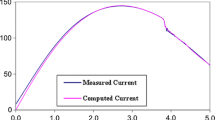Abstract
The results of experiments on increasing the specific energy density of high-current Z-pinch plasma by using various compression modes are presented. The experiments were carried out with cascade wire cylindrical loads at the Angara-5-1 facility with a current in the load of up to 4 MA. The experiments used loads both with a reduced inductance at the final stage of pinch compression and loads that make it possible to implement a transient compression mode from a cascade scheme to a composite Z-pinch scheme. When cascade arrays, which have a reduced inductance at the final stage of compression, are compressed, the specific power of soft X-ray emission is higher than 5 TW/cm, which corresponds to the radiation power with a pinch of a standard length of 1.6 cm at the level of 8–9 TW. The specific total X-ray emission yield is about 150 kJ/cm for a total emission yield at a level of 90–95 kJ. The compression dynamics of such a load indicates a significant role of the magnetic field of the current flowing through the inner cascade in the interaction of the cascades. It is shown that in the transient compression mode from a cascade array to a composite Z‑pinch, the outer array of a material with a relatively low atomic number (Al) provides a high kinetic energy flux density, while the inner array of a small diameter made from a material with a high atomic number (W) allows one to increase the radiation power three times.










Similar content being viewed by others
REFERENCES
V. P. Smirnov, Plasma Phys. Control. Fusion 33, 1697 (1991).
R. E. Olson, G. A. Chandler, M. S. Derzon, D. E. Hebron, J. S. Lash, R. J. Leeper, T. J. Nash, G. E. Rochau, T. W. L. Sanford, N. B. Alexander, and C. R. Gibson, Fusion Sci. Technol. 35, 260 (1999).
F. J. Wessel, B. Etlicher, and P. Choi, Phys. Rev. Lett. 69, 3181 (1992).
S. V. Zakharov, V. P. Smirnov, V. A. Gasilov, A. Yu. Krukovskii, and K. V. Skorovarov, Preprint No. 4587/6 (Kurchatov Institute of Atomic Energy, Moscow, 1988).
S. V. Zakharov and V. G. Novikov. Preprint No. 061 (Keldysh Institute of Applied Mathematics of the Russian Academy of Sciences, Moscow, 2002).
Z. A. Al’bikov, E. P. Velikhov, A. I. Veretennikov, V. A. Glukhikh, E. V. Grabovskii, V. M. Gryaznov, O. A. Gusev, G. N. Zhemchuzhnikov, V. I. Zaitsev, O. A. Zolotovskii, Yu. A. Istomin, O. V. Kozlov, I. S. Krasheninnikov, S. S. Kurochkin, G. M. Latmanizova, et al., At. Energ. 68, 26 (1990).
G. M. Oleinik, Instrum. Exp. Tech. 43, 328 (2000).
G. S. Volkov, E. V. Grabovskii, V. I. Zaitsev, G. G. Zukakishvili, M. V. Zurin, K. N. Mitrofanov, S. L. Nedoseev, G. M. Oleinik, I. Yu. Porofeev, V. P. Smirnov, and I. N. Frolov, Instrum. Exp. Tech. 47, 201 (2004).
A. V. Branitskii and G. M. Oleinik, Instrum. Exp. Tech. 43, 486 (2000).
G. S. Volkov, V. I. Zaitsev, E. V. Grabovskii, M. V. Fedulov, V. V. Aleksandrov, and N. I. Lakhtyushko, Plasma Phys. Rep. 36, 191 (2010).
Ning Cheng, Ding Ning, Liu Quan, Yang Zhen-Hua, Fan Wen-Bin, and Zhang Yang, Chin. Phys. Lett. 23, 1857 (2006).
S. V. Lebedev, R. Aliaga-Rossel, S. N. Bland, J. P. Chittenden, A. E. Dangor and M. G. Haines, Phys. Rev. Lett. 84, 1708 (2000).
ACKNOWLEDGMENTS
We are grateful to the staff of the Angara-5-1 facility for technical support during the experiments.
Funding
This work was supported by the Russian Foundation for Basic Research (project no. 20-02-00133).
Author information
Authors and Affiliations
Corresponding authors
Ethics declarations
The authors declare that they have no conflicts of interest.
Additional information
Translated by L. Mosina
Rights and permissions
About this article
Cite this article
Volkov, G.S., Grabovsky, E.V., Gritsuk, A.N. et al. Increasing the Specific Energy Concentration of High-Current Z-Pinch Plasma by Using Transient Compression Modes. Plasma Phys. Rep. 48, 337–345 (2022). https://doi.org/10.1134/S1063780X22040146
Received:
Revised:
Accepted:
Published:
Issue Date:
DOI: https://doi.org/10.1134/S1063780X22040146



